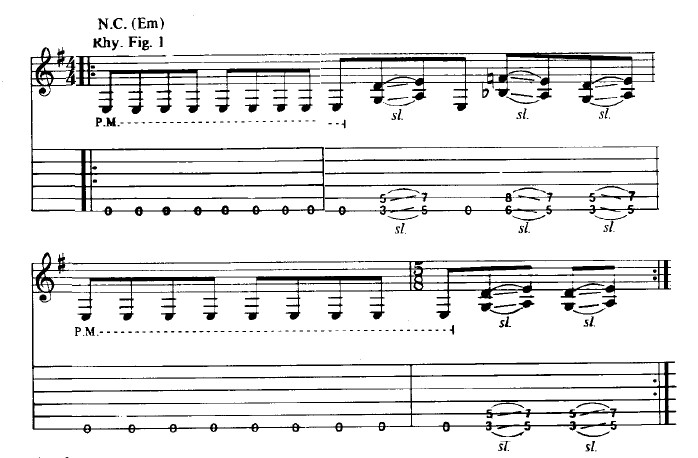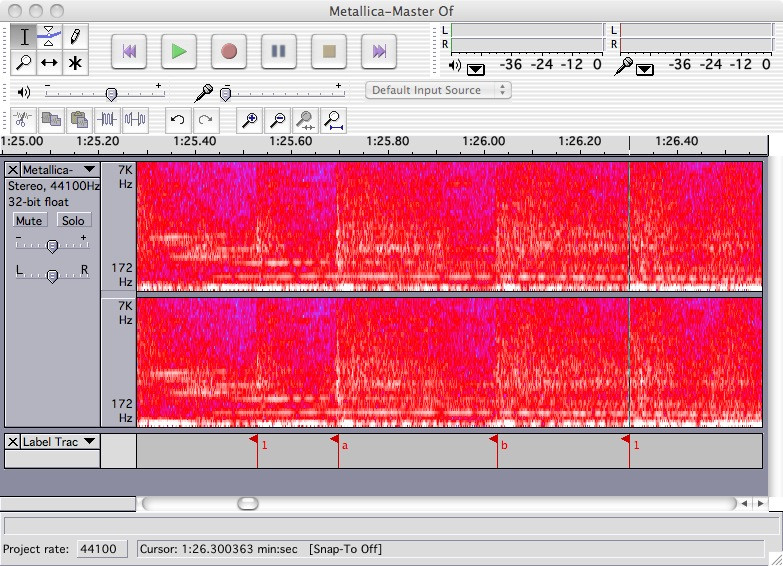Metallica’s “Master of Puppets” is a titan in the realm of thrash metal, celebrated for its relentless energy and intricate composition. Released on the eponymous 1986 album, widely regarded as a cornerstone of the genre, the song has captivated critics and fans alike for decades. Its status as a live performance staple and a favorite among guitarists learning metal is undeniable. The sheer volume of guitar tabs available online for “Master of Puppets” – websites like ultimate-guitar.com boast dozens, excluding full album transcriptions – speaks volumes about its popularity and enduring appeal for musicians eager to learn its secrets.
Yet, for those delving into “Master of Puppets” guitar tabs, a rhythmic quirk often emerges, particularly within the verse riff. The song is characterized by frequent meter changes, and this riff typically features several bars of 4/4 time signature punctuated by a measure often notated as 5/8.
 Verse riff notation from a 1988 Cherry Lane Music Company transcription, Creeping Death Music copyright
Verse riff notation from a 1988 Cherry Lane Music Company transcription, Creeping Death Music copyright
This 5/8 measure, however, presents a subtle conundrum. Listening closely to the album version and various live performances, the rhythm doesn’t quite align with a strict, evenly timed 5/8. It feels…off. This phenomenon touches upon the academic field of music cognition and “microtiming deviations,” often studied in contexts like rubato or timing variations between soloists and ensembles, particularly in jazz. But in “Master of Puppets,” something different seems to be at play.
To investigate this rhythmic nuance, I employed Audacity, a freely available audio editing software, to analyze the original album recording of “Master of Puppets”. Audacity’s spectrum view mode makes visualizing drum hits in rock recordings remarkably clear. By zooming in and meticulously placing labels at the onset of each beat, accurate timing measurements, down to milliseconds, become possible. Calculating the “inter-onset interval” – the duration between successive beats – provides a powerful method for scrutinizing the rhythmic feel of performances featuring drums or percussive instruments like guitar or piano. This technique, while less effective for sounds with less defined attacks like vocals or bowed strings, is ideal for dissecting the precise rhythmic nuances of Metallica’s performance.
 Audacity analysis of "Master of Puppets" rhythm
Audacity analysis of "Master of Puppets" rhythm
To ensure a robust analysis, I focused on the verse riff, examining eight instances of the 5/8 pattern within the first verse. This provided a substantial dataset for comparison. I also measured the surrounding quarter note beats, clearly delineated by the drum pattern, as a rhythmic reference point. The resulting timing data, presented in the table below, reveals a consistent and intriguing rhythmic pattern in Metallica’s execution.
Timing Analysis of “Master of Puppets” Verse Riff (Album Version)
| Measure Instance | 1st Eighth Note (sec) | 2nd Eighth Note (sec) | 3rd Eighth Note (sec) | 4th & 5th Eighth Notes (sec) |
|---|---|---|---|---|
| Instance 1 | 0.15 | 0.14 | 0.15 | 0.34 |
| Instance 2 | 0.15 | 0.15 | 0.15 | 0.35 |
| Instance 3 | 0.15 | 0.15 | 0.14 | 0.34 |
| Instance 4 | 0.14 | 0.15 | 0.15 | 0.35 |
| Instance 5 | 0.15 | 0.14 | 0.15 | 0.34 |
| Instance 6 | 0.15 | 0.15 | 0.14 | 0.35 |
| Instance 7 | 0.14 | 0.15 | 0.15 | 0.34 |
| Instance 8 | 0.15 | 0.14 | 0.15 | 0.35 |
| Average | 0.14875 | 0.1475 | 0.1475 | 0.34375 |
The data indicates a remarkably consistent eighth note duration of approximately 0.15 seconds and a quarter note duration (two eighth notes) around 0.29 seconds, except within the 5/8 measure. After the initial three eighth notes in the 5/8 bar, a subtle pause of about 0.04 to 0.05 seconds—roughly a third of an eighth note—occurs before the final two eighth notes. This pause extends the combined duration of these last two eighth notes to approximately 0.34 or 0.35 seconds. Unlike rubato or other microtiming deviations typically studied in music theory, this rhythmic characteristic is performed uniformly by the entire band. It’s not a fleeting deviation corrected later in the phrase but a persistent shift in the perceived beat.
This strategically placed pause within the 5/8 measure profoundly disrupts the song’s rhythmic pulse. Even if the eighth notes were played with perfect evenness, the 5/8 measure itself, being an odd time signature, would inherently challenge the established quarter and half note pulses. The 5/8 measure accentuates the second and fourth eighth notes, contrasting with the preceding 4/4 measures, and subsequently, the following measures reinforce this new rhythmic emphasis. This “new pulse location” effect has been previously noted by scholars like Glenn T. Pillsbury in his book Damage Incorporated: Metallica and the Production of Musical Identity.
For a long time, I questioned the accuracy of transcriptions depicting a 5/8 measure, suspecting a notational error. It was only through precise timing analysis that I confirmed the presence of the 5/8 and, more importantly, uncovered its unique rhythmic interpretation by Metallica. This raises a valid question: can we truly classify this as a standard 5/8 measure when one of its implied eighth notes is consistently lengthened by roughly 30%?
The answer is nuanced. Notating the riff with a 5/8 measure remains arguably the most practical approach for guitar tabs intended for learning and performance. It provides a readable framework for guitarists. However, it’s crucial to acknowledge that this notation doesn’t fully capture the recorded reality. The subtle rhythmic shift Metallica introduces significantly alters the feel of the riff. Try playing the riff with perfectly even eighth notes according to a standard 5/8 feel, and the absence of that characteristic “lurch” – that surge of rhythmic tension – will be immediately apparent. This “inexact” timing is integral to the visceral impact of “Master of Puppets,” contributing to the adrenaline rush experienced while headbanging to this iconic track.
If meter is defined by the felt pulse of the music, then this “Master of Puppets” 5/8 measure transcends the conventional definition. While 5/8 serves as a functional notational tool, it doesn’t fully encapsulate the distinct rhythmic shape and physical impact of Metallica’s performance. Perhaps no time signature can perfectly capture this rhythmic subtlety, but recognizing the deviation from a strict 5/8 is key to understanding the true rhythmic genius embedded within “Master of Puppets” guitar tabs and the song itself.
